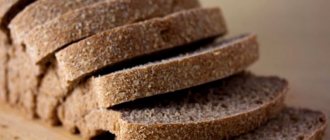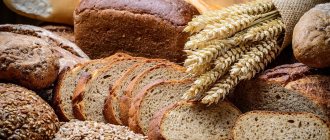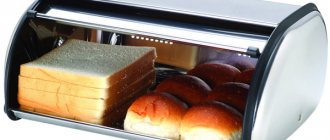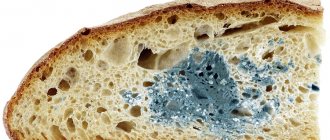Popular wisdom says: “No bread - teeth on the shelf.” Therefore, housewives try to have a supply of loaves and rolls at home, but not everyone knows how to store bread correctly. You cannot throw away the product, because this is disrespect for people’s work, a sign of the loss of family well-being and prosperity. Meanwhile, to prevent bread from becoming moldy or stale at home, it is enough to choose any of the eight proposed storage methods.
In the bread bin
The stores offer a wide range of models made from various materials:
- plastic;
- metal;
- tree;
- bamboo.
A wooden bread box will keep your bread fresh longer. Wood “breathes”, creating a comfortable microclimate inside for baked goods. But at the same time, the material quickly absorbs odors and becomes dirty, so the bread bin will have to be replaced every 2-3 years.
The best bread bins are made from juniper, birch or larch. The wood of these species has bactericidal properties.
Steel models are practical and durable, in which bread is also stored well. They, unlike wood, can be washed using cleaning products to remove dirt and stains.
When choosing plastic, pay attention to the quality of the material and the presence of odor. Models with a strong plastic smell are not suitable for bread storage.
Storage time for bread in bread bins made of different materials:
- wood - up to two days (then the loaves will begin to stale);
- plastic, metal – up to three days (then mold may appear).
Any bread bins require systematic care. Once every 5-7 days, wipe the inside of the shelves with a damp cloth, and then thoroughly dry the box.
Useful tips
To prevent the bread from going stale longer, cut pieces not from the edge, but from the middle: divide the loaf in half, cut the required amount from the middle. Connect the remaining halves with slices, pressing them tightly against each other.
If the bread is slightly stale, you can refresh it. Spray the product with water or wrap it briefly in a damp towel. Then place in an oven preheated to +120 ℃ for 10-15 minutes. The bread will restore freshness and softness for several hours (wheat up to 5 hours, rye up to 9 hours).
To prevent mold, place a handful of salt or an apple slice in the bread bin (they need to be changed periodically). Charcoal wrapped in gauze will get rid of excess moisture and unpleasant odors.
Don’t forget to wash the bread bin once a week and treat it with a weak solution of vinegar (and then dry it thoroughly).
To prevent the bread from getting stale during the festive feast, serve it to the table in a wicker basket, wrapped in a linen towel.
Remember that bread made with yeast-free sourdough is stored better than bread made with yeast dough, as it is less susceptible to the development of fungus. The product will remain fresh longer (7-8 days) if you use vegetable rather than animal fats for cooking.
We hope that our recommendations will be useful to you. How are you used to storing bread? Share your experience in the comments.
How to store bread in plastic
A common option to prevent bread from going stale is to put the rolls or loaf in a plastic bag. It retains moisture well and prevents baked goods from drying out. But a “greenhouse” effect is created inside the package, so holes are first made in the bag.
Air circulates through the holes, preventing the formation of condensation inside and the appearance of mold on the edges of the bread. Holes are made with a knife or fork, and the bags are changed every time. Instead of polyethylene, it is allowed to use metal food foil.
How long do crackers last?
If crackers are packaged taking into account the requirements for proper storage of bread, they can retain satisfactory nutritional qualities for a very long time, even several years. Rusks made from black bread last twice as long as from white bread. The main danger is moisture, which immediately creates favorable conditions for mold. But quick drying prevents the crackers from spoiling, although they become a little harder.
Small mold processes still occur in breadcrumbs. This is similar to periodic injections during periods of brief revival of the mold fungus. Since it produces mycotoxins, these substances gradually accumulate in the breadcrumbs. Therefore, crackers should not be stored for too long even in ideal conditions, a maximum of 6 months.
In fabric
It is believed that this method is environmentally friendly and simple. The loaf is wrapped in a large linen napkin or towel and placed in a bread bin or any other container.
Instead of towels, fabric bags are suitable. The fabric must be natural, without mixed additives or synthetics. In this material, baked goods will remain fresh for up to 4-5 days.
Black and white - together or apart?
Grey, black, white: each species has its own individual microflora. And loaves of different types, if placed together, begin to quickly deteriorate.
It is recommended to keep white and black bread apart or pack it in separate bags.
The reasons for the impossibility of storing different varieties together is that white and dark have different amounts of water in the mass of flour. Black contains 80% water, white - about 60%.
In addition, the rich smell of black is absorbed by white loaves.
If wet and moldy spots appear on the pieces, then they are not suitable for food!
Storing bread in ceramic dishes
Ceramic pots, pans, pots are suitable for storing loaves and rye loaves. What to pay attention to:
- baked goods made from wheat flour are stored separately from rye loaves;
- containers must be spacious.
Ceramics will keep bread fresh for up to 5-7 days.
Expired bread
When buying bread or bakery products in a store, you should definitely inspect it. Its appearance, at first glance, should please the eye. The product itself should not be dented or cracked.
Under no circumstances should there be a black or green coating on the bread. The product should have its own unique aroma, and not the smell of mold.
If the bread was not baked (the technology was violated), if it was not stored correctly (the rules of transportation and storage in the warehouse were violated), or if the composition includes expired bread products, mold appears on such a product.
You should absolutely not consume baked goods even if there is a hint of mold!
Some people cut off the mold-damaged crust and eat the bread. Diseases associated with the respiratory and blood organs may occur here.
If the bread contains an expired product, then when you press on the bread you will notice a slight smell of mold. If you put pressure on the bread, but it does not come back, then the loaf is not baked and should not be consumed.
In paper
In supermarkets, baked goods are often sold in special paper bags in the bakery departments. They are suitable for storing loaves, protect from dust, dirt, allow the bread to “breathe”, but do not protect against drying out. For 1-2 days of storage, this method will do; for a longer period, other options should be considered.
Shelf life and storage of bakery products according to GOST
First of all, it is worth noting that the state standard for storing bread is established within the framework that is calculated for the sale of the product. This means that the actual shelf life of bakery products is slightly higher than the prescribed values. There are 2 types of GOST standards, which depend on the type of product, the method of its preparation and the presence of packaging.
- For products that can be stored for no more than 2 days. The packaging must contain not only the date, but also the time of packaging.
- For products that can be stored for more than 48 hours. The label will be marked with the date of packaging.
Storage standards for main types of bakery products:
- cut: in packaging – 72 hours, without packaging – 24 hours;
- white of the first category: in packaging 72 hours, without packaging – 24 hours;
- small loaves up to 200 g – no more than 16 hours;
- Borodinsky - 36 hours;
- crackers – 60 days.
How to store bread in the freezer
Many people consider the refrigerator a panacea for spoilage of any food, so they boldly put loaves and loaves of bread on the shelves. But as a result of such storage, baked goods quickly lose moisture and become stale. On the upper shelves of the unit the temperature is +2ºC, and it is at these levels that the loaf dries out in a couple of days.
It is better to place the baked goods in the freezer, after cutting them into slices and packing them in plastic or cling film.
Shelf life in the freezer at different temperatures:
- -16ºC…-18ºC – 3-4 months;
- -25ºC – up to six months.
The cut slices are taken out as needed and defrosted at room temperature. Defrosting time depends on the weight of the bread: a loaf will take about two hours, cut slices will defrost in half an hour.
To speed up the defrosting process of bread, a microwave is useful.
It becomes moldy and stale - why does bread spoil?
Even a couple of days after purchase, mold forms on a seemingly fresh loaf or roll. It occurs for several reasons:
- the manufacturer did not follow the baking technology, used low-quality raw materials (flour, excess water);
- storage conditions have been violated. In rooms with humidity levels of 70% or more, mold appears and spreads very quickly;
- in a store or during preparation, the product was exposed to fungal spores, which successfully reproduce in the comfort of your home.
Under no circumstances should you eat moldy bread. In addition to the disgusting taste, such a product is dangerous to health and can cause serious food poisoning.
Sometimes the bread does not become moldy, but becomes stale. This is due to the transition of free starch from one state to another. When baking, starch combines with water, resulting in an elastic crumb. Then, after some time, the starch takes on a crystalline state, the water from the crumb evaporates, and as a result the bread becomes stale.
Unlike moldy bread, stale bread can be refreshed. An increased temperature of 50-60 degrees leads to a reverse reaction, as a result the product acquires softness and a pleasant fresh aroma.
Cooks advise putting the dried bread in an oven heated to 60 degrees for 15-20 minutes.
Storage in special bags
Reusable special bags equipped with perforated gaskets are becoming popular. Thanks to the special structure of the material, packaged loaves, long loaves and rolls remain fresh for up to 10-12 days.
Due to perforation, excess moisture is absorbed, the crumb does not dry out, the bread crust does not soften, and mold does not form. The bags are sold in sets, and manufacturers produce packaging in different sizes - “long” for baguettes and standard for regular loaves and loaves.
How are crackers different from stale bread?
The transformation of bread from fresh soft to stale hard is a chemical process in which the starch contained in bread changes from an amorphous state to a crystalline state. During the baking process, flour starch binds water, becomes amorphous, its granules soften and an elastic crumb is formed under the bread crust. But gradually the bread loses moisture, and the starch grains become denser and smaller, and air cavities form between them.
Stale bread is not at all the same as artificially dried bread, i.e. crackers. In the process of drying crackers, starch loses water much faster and the air cavities between its grains are large, the entire structure of the product becomes “airy”, without very hard seals characteristic of stale bread. Therefore, when eating crackers, saliva quickly wets all starch grains, returning them to their previous amorphous (soft) state. Stale bread is poorly saturated with saliva and is much less digestible, even if it is consumed in crushed form.
How to store bread in enamel dishes
Loaves of rye and wheat, placed in large pans, retain their freshness well. Cover the container with a lid on top and place a whole green apple inside.
The fruit will prevent the bread from drying out for 3-4 days, and for reliability, you can additionally wrap the baked goods in canvas.
Simple tips for storing bread
The fact that bread goes stale should not surprise anyone. This is a natural process associated with the loss of moisture from starch. Starch is included in baked goods; after a while, the structure of the ingredients is disrupted and the crumb crumbles due to shrinkage.
Bread without additives goes stale within 2-3 days. If the loaf remains fresh after 5-6 days, there is reason to think about the composition of the baked goods and the presence of harmful preservatives in it.
It is impossible to avoid hardening, but it is possible to slow down the process by using the right storage methods. It is worth listening to the advice of experts:
- Hot bread should not be placed in bags or a bread bin until the loaf has completely cooled.
- Black loaves are stored separately from loaves and rolls of wheat bread.
- A sliced loaf or loaf is a product for long-term storage. During the preparation process, special processing compounds are used to increase shelf life.
- To keep baked goods fresh, place a handful of table salt on the shelf of the bread bin.
- The optimal humidity for any baked goods is no more than 80%.
- You cannot store a stale and fresh loaf in the same bag or bread box.
Storage methods
The speed at which a product deteriorates depends on several factors:
- type of flour (chemical composition and quality). For example, bread containing rye or soy flour stays fresh longer . But the addition of barley and corn flour leads to rapid hardening ;
- recipes;
- presence of taste improvers;
- moisture content of bread;
- production technologies;
- storage conditions.
If we cannot influence the composition and process of preparing store-bought bread, then we can control the last factor. We offer you several storage options.
Bread stays fresh longer if it contains a lot of protein products: milk, eggs or soy flour. Flavor improvers such as sugar, glucose syrup, and malt enzymes also slow down the process. Intensive kneading and the long fermentation process of semi-finished products have a positive effect on the freshness of bread. Therefore, when purchasing, it is better to find out the exact composition of the product (the manufacturer is obliged to answer this request).
Paper and natural fabric
How to store bread so it doesn't go moldy? Use environmentally friendly materials such as paper or natural fabric.
Once the bread has cooled, place it in a clean paper bag and seal tightly. For each bun you need to use a separate container. The loaf can be wrapped tightly in a towel or placed in a bag made of natural fabric (linen, cotton). The fabric must be ventilated and washed periodically.
Store the product away from direct sunlight in an area with good air circulation, such as a kitchen cabinet away from the stove . How long will the product retain its original properties? Under these storage conditions, bread will remain fresh for up to 5 days.
In the old days, the product was wrapped in linen or canvas fabric. Today you can find special three-layer bread bags on sale.
Breadbox
The main and most convenient place to store baked goods is the bread bin. Give preference to metal models - this material has good thermal insulation properties and does not absorb odors. Bread bins made of glass and clay will do the job well, but they are quite fragile. Plastic models also cannot boast of durability.
Some housewives choose eco-friendly wooden bread bins, for example, made from juniper or birch bark, as they have antiseptic properties. However, wood is highly hygroscopic and requires careful care, otherwise the material quickly becomes damp and moldy.
Bread of different varieties should be stored separately. When buying a bread bin, give preference to a model with 2-3 sections. If the bread box has 1 section, pack the bread in different bags and store it at a distance from each other
In a high-quality bread box, baked goods can be stored for up to 7 days (it is recommended to first wrap the product in a linen towel) . The bread box should close tightly and have a minimum number of ventilation holes. Observe an important condition - keep the bread bin in a dry, bright place away from the sink and stove.
Foil and polyethylene
Many housewives use plastic bags or food foil to store food - they retain moisture well and prevent the bread from drying out. But due to the heat and humidity inside the package, a greenhouse effect occurs and condensation forms - an ideal environment for the growth of bacteria. To avoid this, you need to make small holes in the bag or foil to ensure air circulation .
To prevent mold, do not reuse foil or storage bags.
Manufacturers package the product in special perforated bags. Store the bread in its original packaging - this way it will stay fresh for up to 3-5 days
Fridge
Most foods stay fresh at low temperatures, but can bread be stored in the refrigerator?
Bread goes stale fastest at temperatures between −2 ℃ and +20 ℃ (peak retrogradation occurs at +4 ℃). Therefore, it is not recommended to store baked goods in the refrigerator .
It has been proven that bread goes stale in the refrigerator 3 times faster than at room temperature.
Freezer
If you want to keep your bread fresh for a long time (from several weeks to 4 months), use the freezer . The process of starch crystallization slows down significantly (until it stops completely) at temperatures below −10 ℃. Once defrosted, the bread will taste almost as good as fresh.
Recommendations for freezing bread:
- set the temperature in the freezer to −18… −15 ℃;
- Only freeze fresh bread at room temperature . Do not store hot or stale food;
- Wrap the bread in a plastic bag or heavy foil. The packaging must be sealed;
- Label the bag with the date of freezing.
Before freezing, cut the bread into pieces and pack into bags, calculating portions for 1-2 meals, this will make the bread easier to freeze and defrost
Bread cannot be re-frozen.
To defrost bread, remove it from the freezer, remove the packaging and leave it at room temperature. To defrost several pieces or half a flatbread, 30 minutes will be enough, for a whole roll or loaf – about 1.5-2 hours. To speed up the process, you can warm the bread in the oven or microwave. Some bread makers are equipped with a defrost mode.










